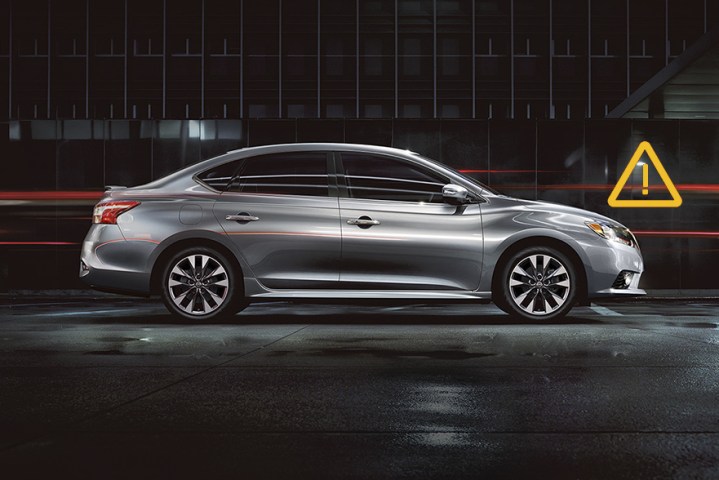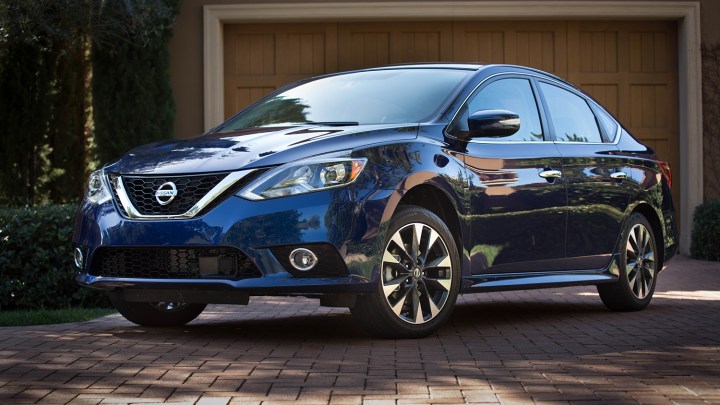
A flawed radar module is disabling the automatic emergency braking system in some newer Nissans, and the company is scrambling to order replacement parts and address the situation.
Intelligent Safety Shield is Nissan’s umbrella term for several technologies meant to assist drivers and boost safety. One of those, automatic emergency braking (AEB), relies on a radar in the front grille to monitor a car’s proximity to the vehicle ahead, warn of possible collisions, and hit the brakes if the driver can’t. But a problem with some of those radar modules — a third-party component supplied by Bosch — makes the sensor frequently deactivate itself, disabling adaptive cruise control and the emergency braking system. A warning flashes on the dashboard to indicate the problem: “Front radar unavailable due to obstruction.”
After Digital Trends identified the issue in the 2018 Nissan Sentra and brought it to the automaker’s attention, the company acknowledged the problem, and said it was working to replace the faulty part.

“Nissan is aware of a relatively limited population of Sentra customers who are reporting conditions similar to that which you described,” Dan Bedore, Director of Communications for Nissan, told Digital Trends. “Our engineering team has identified the cause to be a supplied-component issue… Nissan is well into the standard process for obtaining counter-measure parts and informing our dealers of the remedy, which is expected in the coming weeks.”
The issue may be wider than just one model, and it underscores a troubling trend in the automotive world: As cars increasingly rely upon technologies such as radar, lidar, and cameras, the limitations of those existing systems is becoming increasingly obvious.
Widespread trouble?
While Nissan would only acknowledge the existence of the issue in Sentras, drivers of several different models report very similar issues, including Armadas, Altimas, and Muranos.

The Intelligent Safety Shield feature is standard on the 2018 Altima, 2018 Leaf, 2018.5 Rogue Sport, 2018 Rogue, 2018 Murano, and 2018 Pathfinder, according to a document posted in May on the company’s site. Nissan claims that different platforms and models use different parts.
Roughly 1,000,000 Nissan vehicles will include standard automatic emergency braking (AEB) by the end of the year, the company says.
“We are working closely with Nissan to support it in the measures it has taken.”
A Bosch spokesman told Digital Trends that it was helping Nissan with the issue, but declined to specify which other automakers use the module, or who make the radar chips within them.
“We hope you will appreciate that, as a matter of principle, we do not comment on actions of our customers. We are working closely with Nissan to support it in the measures it has taken. We hope you will understand that only the automaker is in a position to answer questions in detail,” the company said.
Recall potential?
AEB systems and other driver assist technologies are growing in popularity, and for once, it appears the technology may not be keeping pace with the demands. Experts describe current automotive radar systems as “shortsighted”: “They lack the resolution to distinguish objects close to the vehicle, while discarded soda cans and other metallic objects can cause false alarms that increase the risk of accidents,” according to the trade magazine Microwaves & RF.

Experts at the National Highway Transportation Safety Administration (NHTSA) heartily endorse AEB and other such systems. “NHTSA believes these technologies represent the next wave of potentially significant advances in vehicle safety,” the company’s site reads. If this is potentially lifesaving technology, should Nissan issue a recall over defective parts?
Reached by email, NHTSA was supportive of Nissan’s efforts. While the warnings are alarming, a spokesman said, the car was responding correctly to the issue, and the driver was never at risk. Recalls are driven in part by the number of complaints, whether a solution is being offered by the manufacturer, and most importantly by the number of related deaths or injuries.
“We recognize the concern that a customer may have when seeing any type of warning message,” Nissan told us. “In this case, the vehicle is communicating to the customer as it is designed to do in the event of a system fault: providing notice that AEB, which was formerly known as forward emergency braking (FEB), is unavailable at this time because of a system issue. It is important to understand that critical safety systems are not affected.”


